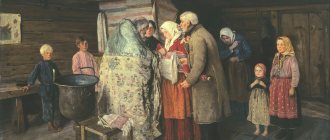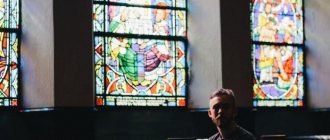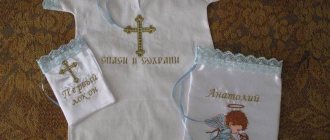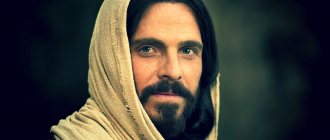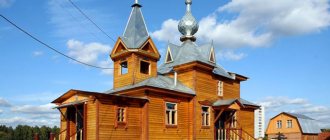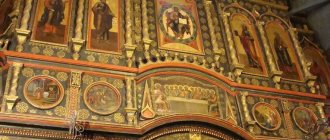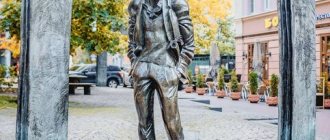1 Peter 3:18-19 says, “For Christ also died once for sins, the righteous for the unjust, that he might bring us to God, being put to death in the flesh but quickened in the Spirit, in whom He also went forth to preach to the spirits in prison. "
In verse 18, the expression "in the spirit" has the same construction as the expression "in the flesh", so it seems that the word "spirit" refers to the same area as the word "flesh", namely, the flesh and the spirit are the flesh and spirit of Christ. The words “but quickened in spirit” indicate that Christ took upon Himself sin and death, resulting in the separation of His humanity from the Father (Matthew 27:46). This is a conflict between the flesh and the spirit (Matthew 27:41 and Romans 1:3-4), not the flesh of Christ and the Holy Spirit. When Jesus paid the full penalty for sin, the broken relationship with the Father was restored.
1 Peter 3:18-22 describes the connection between Jesus' suffering (verse 18) and His glorification (verse 22). Peter is the only one who gives information about what happened between these two events. The word “preach” used in verse 19 is different from the New Testament standard description of spreading the gospel. It literally means a harbinger of a message. Jesus suffered and died on the cross, His body died and His spirit too, taking on sin. But His spirit came to life, and He gave it to the Father. According to Peter, between His death and resurrection, Jesus preached to “the spirits in prison.”
First of all, Peter describes people as “souls” and not “spirits” (1 Peter 3:20). In the New Testament, the word "spirit" is used to describe angels and demons, not people; This seems to be what verse 22 is referring to. Nowhere in the Bible does it say that Jesus visited the lake of fire. Acts 2:31 says that He was not left in “hell,” but “hell” is not the lake of fire (inferno). The word "hell" describes the world of the dead, not a permanent place where they await resurrection. Revelation 20:11-15 gives a clear description of these two passages and their differences. The lake of fire (inferno) is the permanent place of stay of the condemned after the final trial, and hell is a temporary place.
Our Lord, having given His spirit to the Father, died and, at some time between death and resurrection, visited the world of the dead in order to proclaim a message to the spirits (most likely fallen angels, see Jude 6) who were somehow connected with the flood in the time of Noah, which is described in verse 20 of 1 Peter 3. Peter did not write what exactly He preached to these imprisoned spirits, but it could not be a message of salvation, because. angels cannot receive it (Hebrews 2:16). Most likely, it was a declaration of victory over Satan and his servants (1 Peter 3:22; Colossians 2:15). Ephesians 4:8-10 tells us that Jesus also visited “paradise” (Luke 23:43) and took with him to heaven all those who believed in Him before His death. The passage does not give details of what happened, but most biblical scholars agree that this is what it means when “He took captivity captive” (Ephesians 4:8).
So, the Bible is not clear on where Jesus spent the three days between death and resurrection, although it appears that He was declaring victory over the fallen angels and/or unbelievers. One thing we can be sure of is that Jesus could not give a second chance of salvation to the dead. The Bible says that we will face judgment when we die (Ephesians 9:27) and there will be no second chance. Of course, we cannot answer specifically what Jesus did between death and resurrection. Most likely, this is one of those secrets that will be revealed when we join Jesus.
Behold the man: the Midnight Savior was shown in the St. Petersburg Manege
“Christ in prison” - huge letters flash white on a black screen covering the entire façade of the St. Petersburg Manege. Inside there is an exhibition of unprecedented design: ancient wooden sculptures of the same iconographic type were brought from the cities of Russia: the Midnight Savior. This is an image of Jesus sitting in captivity on the eve of the procession to Calvary.
But there is no need to be afraid that the exposure will be monotonous. In terms of plasticity and transmitted condition, all images are different. And the exhibition itself is designed in such a way that moving through it becomes an adventure. Twilight reigns in the Manege; disturbing sound waves permeate the space. Against the backdrop of a video projection of the snow-covered taiga, the public is greeted by the first Christ. It seems to grow from the trees of the northern forest, the same ones that in ancient times served our ancestors as material for making idols. The popular veneration of wooden Christ, the Mother of God, and saints is rooted in paganism: these statues were painted to match the color of the human body, wrapped, shod, and “fed” with steaming hot food.
Photo: IZVESTIA/Sergey Konkov
“Perhaps this forest also serves as a hint at the difference between Russian wooden sculpture and foreign ones,” Nadezhda Belyaeva, president of the Perm Art Gallery, told Izvestia. — Western sculpture came out of the workshop, ours came out of the forest. The Christ presented here to a Western person may seem rude, “uncouth,” since that tradition put the reception at the forefront, and ours - sincerity and nakedness of feeling.
When you hear about religious wooden sculpture, you remember first of all the Perm collection, known throughout the world. There is a beautiful legend that when in the 1970s negotiations were held about the “visit” of the Mona Lisa to the USSR, the only thing that the Louvre agreed to accept as collateral was the “Perm gods”. But Perm provided Manege with only four figures of Christ. The Tretyakov Gallery and St. Petersburg collections also provided something, but the main body of work were works from the cities of the middle zone. Ryazan, Uglich, Tver, Cherepovets, Totma, Morshansk... A total of 33 Christs from 14 museums.
Photo: IZVESTIA/Sergey Konkov
“We, on principle, did not bring foreign exhibits, we did not place Russian sculpture in any context,” explained the curator of the exhibition, rector of the St. Petersburg Academy of Arts Semyon Mikhailovsky. — This is not a scientific exhibition, but rather an installation using museum rarities. We did not plan to collect exactly 33 sculptures of Christ, it just happened that way. But the fact that there are 12 large stones laid out on the floor on the first floor is a conscious decision, this is a biblical number. Exhibition designer Anton Gorlanov and I wanted to visualize the gospel phrase “and the earth shook and the stones were scattered.”
Get into the “Hoffmaniad”: dolls from the cartoon were exhibited at the Roerich Museum
The Sandman and the Lord of the Fleas stepped off the screen and into the exhibition halls
The exhibition is located on two floors. Below there are several niches made of huge felt sheets, in each of which there is Christ. This is an analogue of a “dungeon”, a booth with windows in which the wooden Savior sat in the temple. And if in the Perm museum the statues are located very close to each other, here there is a significant distance between them, emphasizing the loneliness of each figure. But in Perm, thanks to daylight, the nuances of carving and coloring are visible, refuting the idea of \u200b\u200bthe primitiveness and roughness of this sculpture. Here, facial expressions and color schemes are distorted, firstly, because of the darkness, and secondly, because of the bright neon rings attached to the heads as halos.
The darkness and heavy background music are intrusive and deprive you of freedom of perception. In terms of atmosphere, this feeling is closer to an ominous gothic, and in some ways even a “panic room,” than to Orthodox art with its light structure. However, the entire composition of the first floor is directed towards the outcome of suffering: the “settled” stones lead the audience to the crucifixion. On both sides there are wooden angels, that is, the Savior has not been abandoned by heaven.
Photo: IZVESTIA/Sergey Konkov
The second floor makes a different impression. A temple-labyrinth in which statues are placed is woven from long metal rods. There are no neon halos. A closed space is associated with lack of freedom, but at the same time it is transparent, allows light and air to pass through, and this is fascinating.
The exhibition “Christ in Prison” presents the Savior beyond mysticism - as a simple person, physically vulnerable, with whom one can easily identify. Anyone can find themselves in deep loneliness and awaiting trials. And the Midnight Savior in all his incarnations teaches us to maintain dignity, wise calm and hope.
— 4 —
Vincenzo Catena. "Christ in Emmaus".
By the Sea of Tiberias
Once again Jesus appeared to the apostles at the Sea of Tiberias.
There were Peter, Thomas the Twin, Nathanael, James, John and two more disciples.
They went fishing, fished all night, but didn’t catch anything. And in the morning they look - Jesus is standing on the shore. But the disciples did not recognize him.
- My children, do you have any food? - Jesus addressed them.
And they answered:
- No.
“Cast the net on the right side of the boat and you will catch it,” Jesus said.
And indeed, they cast a net, but could not pull it out because of the multitude of fish.
- It's the Lord! - exclaimed one of the apostles.
Peter girded himself with his clothes, for he was naked, and threw himself into the water.
Other students arrived in the boat. On the shore they saw a fire laid out and fish and bread lying on it.
“Bring the fish you just caught,” Jesus commanded.
They pulled out the net, and there were one hundred and fifty-three large fish in it, and with such a multitude, the net did not break. “Go to dinner,” Jesus told them.
None of the disciples dared to ask him: “Who are you?”, for they knew that it was the Lord.
Jesus took the bread and the fish and gave it to them.
This is how Jesus appeared to the apostles for the third time after his resurrection from the dead.
"Biblical Legends". Derbent, Interexpress. 1992
* * *
"Christ Pantocrator". Velikiy Novgorod. Zverin Monastery. Church of Simeon the God-Receiver. 1468.
Ascension
For forty days Jesus appeared to his disciples. He commanded them not to leave Jerusalem:
- John the Baptist baptized with water, and in a few days you will be baptized with the Holy Spirit.
“Is it not this time that you, Lord, will restore the kingdom of our people?” - asked the apostles.
“It’s not your business to know times and seasons,” answered Christ. “You will receive power when the Holy Spirit comes upon you, and you will testify about me throughout the world.”
Jesus said this, stood up, and a cloud hid him from the eyes of his disciples.
"Biblical Legends". Derbent, Interexpress. 1992
* * *
N. Koshelev. "Christ in glory."
The Last Judgment
“When the Son of Man comes in his glory,” said Jesus, “and the angels come with him, when he sits on the throne of his glory, all nations will be gathered before him, and he will separate one from another, as a shepherd separates the sheep from the goats.” The sheep will stand on the right hand, and the goats on the left. And the Heavenly Father will say to those on the right:
“Draw near, blessed ones, inherit the Kingdom prepared for you from the foundation of the world, for I was hungry and you fed me, I was thirsty and you gave me drink, I was a stranger and you sheltered me, I was naked and you clothed me, I was sick, and you did not shy away from me, I was in prison, and you visited me.”
Then the righteous will answer:
"God! When did we see you hungry and feed you, thirsty and give you something to drink, a stranger and sheltered you, naked and clothed you, sick or in prison?”
“Truly I tell you,” the Heavenly Father will answer, “what you did to one of the least of my brothers, you did to me.”
Then your Father in heaven will say to those on your left hand:
“Depart from me, you cursed, into the eternal fire prepared for the devil, for I was hungry and you did not feed me, I was tormented by thirst and you did not give me anything to drink, I was a stranger and you did not shelter me, I was naked, and you did not clothe me, I was sick and in prison, and you did not visit me.”
“When was this, Lord?” - they will ask.
And the Heavenly Father will say to them:
“Truly I say to you, whatever you did not do to one of my younger brothers, you did not do to me.”
And some will go into eternal torment, and others into eternal life.
"Biblical Legends". Derbent, Interexpress. 1992
* * *
El Greco. "Christ the Savior."
Let us recall that Christian images of the cross are often accompanied by the inscription KING OF GLORY, referring specifically to Christ.
Thus, according to tradition, Christ is the King of Glory. This expression can be interpreted in different ways. But now we are beginning to realize that he must be understood quite literally: Tsar of the Slavs.
Thus, having found correspondence with the New Testament, we get a wonderful opportunity to take a fresh look at the gospel story of the confrontation between Herod and Jesus Christ. What is briefly stated in the Gospels in only a few verses, on the pages of Russian chronicles, it turns out, has survived in a much more detailed version. True, the chronicles have reached us only in a tendentious Romanov version. Nevertheless, as we see, they preserved many genuine details that illuminate the gospel stories with a new, unexpected light.
G. V. Nosovsky, A. T. Fomenko. "King of the Slavs."
* * *
Fra Bartolomeo. "The Risen Christ with the Saints."
Modern researchers draw information about the “ancient” Egyptian religion mainly from the following sources. Firstly, Plutarch’s work on Isis and Osiris, in Greek, has been preserved. True, historians are wary of him. In their opinion, there are many errors: “Plutarch identifies some Egyptian gods with Greek ones and introduces into the text numerous statements that are the fruit of his own imagination or the result of inaccurate information.” But some of the alleged errors may turn out to be the result of errors not of Plutarch, but of the historians themselves. Although, of course, Plutarch’s mistakes are also not excluded.
Further, in addition to Plutarch, researchers have at their disposal numerous Egyptian images and texts. However, as for the “ancient” Egyptian texts, the task of translating them into modern languages is quite difficult. Despite the decoding of the hieroglyphs, the meaning of many “ancient” Egyptian terms still remains unclear. Therefore, modern translations of hieroglyphs and papyri turn out to be quite dark. And sometimes even contradictory. For example, when discussing one of the ancient papyri, Egyptologist E. Budge is forced to declare that, they say, “Egyptian scribes did not very well understand what they were writing.” But, most likely, the issue is not the ignorance of the scribes, but the inability of modern commentators to fully understand the meaning of the authentic “ancient” Egyptian texts. Therefore, their translations must be treated with caution. To a large extent, they are only a kind of interpretation of material that is not entirely clear to translators.
The closeness of the Egyptian god Osiris to Christ is so obvious that it has been noted by many researchers. Moreover, this fact was well known in the medieval Christian tradition. The correspondence between Osiris and Christ embraces almost all the main points of the teaching about Christ. In addition, many other statements of the Bible and church tradition are also reflected in the “ancient” Egyptian myths.
G. V. Nosovsky, A. T. Fomenko. "King of the Slavs."
* * *
Fernando Gallego. "Blessing Christ."
It is believed that the Greeks also knew Osiris and likened him to Dionysus, Adonis and Bacchus. But the name DIONYSUS or DIO-NIS is naturally perceived as GOD-NIKA, the God of Nicea. Let us remind you that the word NICEA in Latin is written with an “s”: Nicea. Therefore, NIKA easily transferred to NISA. It all depended on how to read S: in Russian (in Greek) - as S, or in Latin - as K. But the combination GOD NIKA fits perfectly with Christ. Let us remember that on crucifixes next to Christ the word NIKA is very often written, see above. In addition, NIKA meant “winner,” which also corresponds well to the name of Christ the VICTOR in church literature. For example, Christ CONQUERED death by his Resurrection. Therefore, he was called God the Victorious or God Nika or Dio-Nis (Ado-Nis). And only later commentators of the 17th-18th centuries came up with the “ancient” Greek supposedly pagan god Dionysus, who supposedly had nothing to do with Christ. Which is not true. The ancient Greeks revered Christ under the name of Dionysus. But this does not mean that their services and modern Christian worship are one and the same.
As for the name BACHUS, it simply coincides with the word GOD. Only the Greek-Latin ending “us” has been added.
G. V. Nosovsky, A. T. Fomenko. "King of the Slavs."
* * *
Deesis. Icon. Fragment. Mid-16th century.
On old Russian, as well as Serbian and Bulgarian, icons depicting Christ, a cross was drawn on the halo around his head and three Church Slavonic letters were written on it. At the left end is the letter “OT” (it was written as the letter Omega with the letter T on top). At the upper end of the cross they drew the letter “ON” with a title (OH was written in the form of the letter O), and at the right end - the letter “IZHE octal”, corresponding to the modern I, but written as the modern N.
On later icons these letters began to disappear. Sometimes all three letters, or some of them, were retained. But almost always - and obviously not by chance - the title above O. disappeared.
Let us ask ourselves what the three letters stood for: OT, OH (with title), IZH on the halo of Christ? For a person familiar with the Church Slavonic notation of numbers, the answer is more or less obvious. This is the number 878. Indeed.
First of all, ALL THREE LETTERS HAVE A NUMERIC VALUE. Let us explain that not all letters of the Church Slavonic alphabet have this property: there are only 9 x 3 = 27. And in total there are 40 letters in the Cyrillic alphabet, taking into account the symbols. BUT ALL THREE LETTERS DEPICTED ON THE HALO OF CHRIST HAVE A NUMERICAL VALUE.
Secondly, ALL THREE LETTERS ON THE HALO OF CHRIST ARE IN THE RIGHT RANKS. Let us explain that in the Church Slavonic notation of numbers (since there is no zero there), different letters are used for units, tens and hundreds. Namely: nine letters for the units place (1, 2, ...9), another nine letters for the tens place (10, 20, ...90) and another nine for the hundreds place (100, 200, ...900). Thousands, tens of thousands, etc. are indicated using special icons next to the letters. It follows that not every ordered set of three Church Slavonic letters and numbers denotes a certain number. It is necessary that the first letter be from the hundreds place, the second from the tens place, and the third from the units place. Otherwise, the entry will be meaningless or, at least, erroneous. But on Christ’s halo the number is written absolutely correctly, without any errors. Namely, when reading from left to right, the first letter OT means 800. The second, OH, means 70. And the third letter IZHE octal means 8. The resulting number is 878.
But that is not all. IN THE CHURCH SLAVIC LANGUAGE THERE IS A RULE DESIGNED FOR HIGHLIGHTING NUMBERS IN A STREAM OF TEXT. Namely, the number is highlighted using titles. Moreover, if the number is multi-digit, the title must be placed above the second letter-number from the right... For example, for a three-digit number, the title will be above the middle letter. THIS IS EXACTLY THIS WE SEE IN THE HALO OF CHRIST...
THEREFORE, THE NUMBER 878 IS WRITTEN ON CHRIST'S HALO.
What could it mean? There is no information in church tradition that the number 878 is somehow associated with Christ himself. It is not mentioned in the Gospels and other texts telling about the life of Christ. On the other hand, this number is very reminiscent of a date. Since we are talking about Russian icons, it is natural to read it according to the Russian-Byzantine era from Adam. That is, according to the standard era of medieval Russian sources. In Russian church documents, the era from Adam was used everywhere until the end of the 17th century, and in some cases even later. Therefore, if a Russian icon depicts some date, it would be very strange if it were not indicated according to the Russian-Byzantine era from Adam.
But then we have exactly two possibilities to read this date. It clearly omits thousands of years, which is quite consistent with the chronology in Russian documents of, say, the 16th-18th centuries. Therefore, we have either the year 6878 or the year 5878 from Adam. The first date, when converted to AD. e., gives the year 1370 AD. e. (from 6878 you need to subtract 5508). The second date gives 370 AD. e. All other possibilities for attributing millennia lead either to dates earlier than the beginning of the century. e., or to the future tense. Which is clearly pointless.
Note that 370 AD. e., being depicted on the halo of Christ, does not make any sense not only in the new chronology, but even in the Scaligerian one. In addition, we discovered the date precisely on Russian icons of the 15th-16th centuries. Which in itself points to the date: 1370 as the most likely. But this date ideally corresponds to the approximate era of the adoption of Christianity that we calculated above. We have already come to the conclusion that the adoption of Christianity occurred at the end of the 14th century, during the era of the Battle of Kulikovo in 1380. And the year 1370 falls right there. Perhaps it meant some major stage on the path to the adoption of Christianity. As you know, it was not accepted immediately, but as a result of quite a long effort.
Let's return to the old icons. It is interesting to see how the attitude towards the mentioned three letters has changed over time. Let us explain that the old icons darkened over time and had to be renewed, that is, painted over again. Many such layers could accumulate. Only in the 19th century did they learn to “reveal” icons, that is, remove the top layers and get to the layers of early writing. Therefore, today, looking at OLD icons, we should be aware that often we see not the old original, but a hidden layer. Which could have been partially lost and in some cases painted on by restorers along the preserved contours. Therefore, if the restorers did not understand something or something seemed strange or wrong to them, they could quite sincerely “correct” the original. That is, correct a “mistake” that is “obvious” to them. Here's why we talked about it. If we turn to the numerous surviving icons with letters on the halo of Christ, we will see that on the overwhelming majority of icons there is no title above the letter O.
The point is this. Three letters - OT, OH with a title, AND octal - for ANY PERSON FAMILIARY WITH THE CHURCH SLAVIC ALBERT they immediately say that a number is written here. Namely, 878. Moreover, the number is written not somewhere in the corner of the icon, BUT ON THE HALO OF CHRIST. But then the question immediately arises - what did it mean? And how does the number 878 relate to Christ? The specialists of the 18th and 19th centuries no longer had answers to this question. We emphasize that in the 18th - 19th centuries the Church Slavonic language was studied in schools. This was a required subject. Very many, even those who completed only three classes of the parochial school, knew the Church Slavonic language and understood Church Slavonic numbers. Therefore, almost any person of that time, having read the Church Slavonic number 878 on Christ’s halo, could immediately ask the question: what does this mean? But there was no answer. Therefore, quite naturally, we took the path of least resistance. On new icons, the title was not placed above the O at all, and when opening old icons, they tried not to update it. Or even overwrite (to be safe).
What we really see on the icons of the 18th - 19th centuries! The letters on the halo of Christ sometimes stand, but the title is missing everywhere. Moreover, sometimes the letters themselves are slightly changed (although rarely).
G. Nosovsky, A. Fomenko. "Baptism of Rus'". Moscow, "AST". 2006
* * *
“The Thriving Tree of Christ (The Fruits of Christ’s Passion).” Beginning of the 19th century.
Elizaveta Boehm (Endaurova). “Dear egg on Christ’s day”!
Elizaveta Merkuryevna Boehm (Endaurova). “For the holiday of Christ”!
Elizaveta Merkuryevna Boehm (Endaurova). “And the child knows that it is Christ’s day”!
Elizaveta Merkuryevna Boehm (Endaurova). “For the holiday of Christ! It’s not the horse that carries, but God that carries!”
…
JESUS CHRIST
PAINTING. ALPHABETIC CATALOG.
SEE ALSO:
Achilles
Views: 3,440
Published in support of Yuri Dmitriev
“Jesus said: Father! forgive them, for they do not know what they are doing. And they divided His garments, casting lots” (Gospel of Luke 23:34).
Last year I visited Solovki.
Despite the fact that I knew about unjust repressions from childhood, it was there that I saw with my own eyes the history of our country as a constant struggle between evil and good. In the Solovetsky monastery, already almost completely restored, with an entirely gold iconostasis, I walked on the stones, which had just been washed from the blood of tens of thousands of innocently convicted and put to death fellow citizens, and thought: what kind of memory would they themselves consider worthy?
In different eras, emperors were depicted on the walls of temples as intercessors and defenders of the church, warriors, with scenes from their lives, and so on. I wanted to imagine what images might be appropriate on Solovki, after everything that happened here. At the end of the trip, a more difficult question arose: what type of traditional iconography of the Savior could be considered the most relevant for our time? How to write such an image?
I returned, but the question remained. Who is He for our time? What is He like for us after millions of deaths in totalitarian regimes? For us, now and today, who are putting up with the violation of justice, with the condemnation and torture of innocents before our eyes?
It was absolutely unclear what this image should be. It was only clear that it should grow out of tradition and should not be far-fetched. It was important for me to create an image that would appeal to a person of my time and my country.
It turned out that we had to look in the past: the image of Christ in prison, especially widespread in Russia in the 17th century. One of its most striking examples is in the Transfiguration Cathedral of the Novospassky Monastery in Moscow. There, in the thickness of the wall, a dungeon was built, with a tiny window with an iron grill, and a carved image of a seated Christ.
Sculptures of Christ were traditionally placed in small wooden “dungeons” with bars, and the sculpture located in the Vologda Museum-Reserve is even chained to a pole with a convict block. Such iconography exists not only in sculpture. There are also icons where He is not a formidable judge, but a defenseless, compassionate and grieving person. I think that this is perhaps the most dramatic image of Christ in art. He has already been condemned, He is sitting in prison before the path of sorrow to Golgotha, any minute Roman soldiers will come and lead him to crucifixion.
In my work I wanted to combine the three-dimensionality of sculpture with the conventions of icon painting, so I added a massive frame with a lattice to the icon, as part of a dungeon wall. For the icon board and for the frame, boards were taken, salted and rolled by the sea, and for the lattice I used real rods of metal fittings.
It was this image that seemed to me to be in tune with those sensations that are increasingly becoming our reality - not only on Solovki, but for everyone personally. Feelings of the hourly trampling of justice and the constant imposition of physical unfreedom, external and internal, which we have recently increasingly seen both in the state and in the church, which we ourselves are becoming increasingly infected with, willy-nilly.
Christ in prison, 2021. Philip Davydov. Wood, encaustic, fittings, 40*28 cm
You can view the icon in color by following the link .
If you like our work, support us:
Sberbank card : 4276 1600 2495 4340 (Pluzhnikov Alexey Yurievich)
Or using this form, entering any amount:
CHRIST'S DUNGEON
It is believed that Jesus Christ was in this prison before he was crucified. This prison, located in the sanctuary of the Church of the Holy Sepulcher, has been one of the most visited places in Jerusalem since the Middle Ages.
On Via Dolorosa1 - the Way of the Cross along which Christ had to walk, next to the monastery of the Sisters of Zion you can see a small Greek Orthodox church. Above its entrance there is an inscription in Greek, English and Russian: “The Prison of Christ.” This church was built on the site of the very prison in which, according to legend, Christ and the robber Barabbas were kept. In a recent study published in Speculum, one of the most prestigious academic journals on the Middle Ages, British professor Anthony Bale notes that, although the Gospels do not indicate the exact location of Christ's prison, it does note that he was thrown into prison immediately after his arrest .
Even in the early Middle Ages, pilgrims flocking to Jerusalem from Europe began to look for this prison. There were several places that could have been her. Since the 12th century, this place has been considered a small Greek church, built on the site of the Roman praetorium - the residence of the procurator, where he held court, which included a prison. It is this building that is officially considered the place where the prison of Christ is located. According to documented accounts of 12th-century pilgrims, the prison contained relics and objects that belonged to or were associated with Christ, such as the chains with which he was bound. According to Professor Bale, this church used to be independent, but in the middle of the 12th century, when the Crusaders took control of the Church of the Holy Sepulcher, they expanded the sanctuary and included this small temple in its complex. Bale also notes in his study that the idea of "suffering" and therefore prison was of paramount importance in the Middle Ages. The Middle Ages was also a time when the concept of Purgatory became very popular among believers. Many sought to “cleanse” sin through suffering, for example, by torturing themselves with the whip. The fascination of medieval pilgrims with the theme of suffering and the subsequent spiritual awakening was vividly described by one Felix Fabri, who visited Jerusalem and the prison of Christ at the end of the 15th century: “Then, when we were all inside, the Saracens immediately closed the doors of the church behind us and locked us in with locks and bolts, as people usually do after they throw thieves into prison. Then they left, leaving us prisoners in a most delightful prison, the brightest and the most spacious. In the garden of the precious tomb of Christ, at the foot of Mount Golgotha, in the middle of the world! Oh, happy imprisonment! What a welcome captivity! What a pleasant retreat! ..."
Today, of course, no one is locking anyone in the prison of Christ. But it is quite possible to get acquainted with the conditions in which both Christ himself and the robber Barabbas were kept. Who is this same Barabbas, whose name is associated with Christ? There is no exact information about what this robber was doing. The Gospel does not indicate whether he was a “political” or just a criminal - who he killed or what kind of unrest he sowed against the Romans. The execution of Barabbas was supposed to take place during the Jewish holiday of Passover, and the procurator Pontius Pilate, according to established tradition, invited the people to choose who they should pardon: Christ or Barabbas. Pilate himself was inclined to release Christ, believing him to be innocent, but the people chose Barabbas. What happened to him after his release is unknown. In the prison of Christ, several underground rooms - chambers - have been preserved. In one of them, with a stone bench with blocks into which one could stick one’s feet, Christ was kept, according to legend. At the bottom of the stone bench, the legs were also chained with chains, as is depicted on the icon of the Midnight Savior located here. Apparently, this cell was a “solitary cell” intended for the most important and dangerous criminals.
Barabbas' chamber is larger and deeper than Christ's prison. It probably held several prisoners at once. The cell has several stone benches, and special devices are built into the walls, with the help of which prisoners were suspended. It is believed that Barabbas’ cell is the very first prison that Christ opened with his Sacrifice: “The Spirit of God is upon Me. He has anointed Me... to give freedom to the captives.”
In the photo: the church in which the prison of Christ is located; entrance to Christ's chamber; entrance to Barabbas' chamber; a painting in the church depicting Jesus Christ in prison.
1 - Via Dolorosa (lat. Via Dolorosa, lit. "Way of Sorrow") - a street in the Old City of Jerusalem, along which, according to Christian tradition, the path of Jesus Christ to the place of crucifixion ran.
21.08.2019
Alexander PARKHOMENKO
Section materials
July 23, 21:38
An exhibition of impressionist Igor Grabar opened at the Russian Museum
July 23, 14:22
An exhibition about Peterhof will open in the Vorontsov Palace
July 21, 14:15
The exhibition “Into battle in the name of Alexander Nevsky” opened in Ust-Izhora
July 21, 12:57
The New Nature exhibition opened at the Manege Central Exhibition Hall
July 21, 11:57
